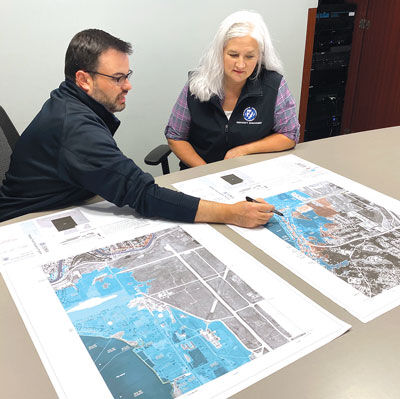
Macomb County’s Emergency Management and Communications team works to be ready for different home and community emergencies.
Photo provided by Brandon Lewis

Members of the Oakland County Emergency Management and Homeland Security Department prepare for community emergencies.
Photo provided by Kevin Sadaj
METRO DETROIT — After a long winter full of snow and ice, spring annually brings new challenges in the form of storm emergencies, specifically thunderstorms and tornadoes.
According to the National Weather Service, most tornadoes occur in southeast Michigan between April and August, with the peak time in June.
Residents can do their best to prepare by creating a plan and stocking their homes with essential items.
Emergency Management Specialist Kevin Sadaj, of the Oakland County Emergency Management and Homeland Security Department; Macomb County Director of Emergency Management Brandon Lewis; and Fire Chief Paul Wells, of the Birmingham Fire Department, shared some tips and resources for local families during storm emergencies.
Storm education
The Oakland County Emergency Management and Homeland Security Department offers several resources on its website, www.oakgov.com/community/emergency-management, that contain important information for storm emergencies.
“We just want people to think about what they are going to do in an emergency,” Sadaj said. “It really entails knowing a little bit of the basics.”
For instance, Sadaj said that it is important that people understand what it means when they hear a siren.
“Oakland County has 276 outdoor warning sirens, and we activate them when the National Weather Service issues a tornado warning or severe thunderstorm warning with damaging winds over 70 miles an hour,” Sadaj said.
To create less confusion and to alert as many people as possible, if one siren is activated in the county, they are all activated. Each siren is capable of reaching about a 1-mile radius of its location.
To stay informed about weather alerts, Oakland county has a self-registering alert system, OakAlert, which emails the community about local emergencies. To sign up, visit oakgov.com.
Macomb County also provides resources for the community through its Emergency Management and Communications. Residents can find information about sheltering during a storm, community preparedness, sirens and more on the Macomb County website at www.oemc.macombgov.org/OEMC-Home.
There are about 140 sirens in Macomb County. Each community owns and operates its own sirens, but it can enter into an agreement with the county to activate the sirens on the community’s behalf.
“This is the first year that Macomb County is on the integrated warning and public alert system through (the Federal Emergency Management Agency), so we can actually send out cellphone alerts in conjunction with our siren activations, and we plan to start doing that this year.” Lewis said. “We would send out one of those alerts if there’s a severe thunderstorm warning with winds greater than 70 miles an hour basically to ensure that, if our sirens go off, people in Macomb County get a cellphone alert.”
Family emergency plan
One of the resources provided by the Oakland County Emergency Management and Homeland Security Department is a family emergency plan.
This family emergency plan walks families through how they will escape their homes if necessary, where they will meet, how to identify risk factors and hazards in the home, and how they will support special health needs within the family.
Wells said the safest place to be during a tornado is in a basement. However, residents without a basement should think about the best place to take cover prior to a tornado warning.
Sadaj said families should also consider their pets in their emergency plans and how they will protect them.
In addition to the county resources, some cities, such as Birmingham, have developed emergency management resources of their own. A Family Preparedness Workbook can be found on the city of Birmingham website, bhamgov.org, on the Fire Department page.
One of the main pieces of advice Wells said is to stay inside after a storm to prevent being struck by falling tree branches. If residents have to escape their homes during or after a storm, it is important to stay away from anything that can fall down.
Emergency kits and equipment
Creating an emergency kit is a key way to prepare for a storm or other emergency. The Oakland County Emergency Management and Homeland Security Department has made a checklist for families to follow.
This kit includes 36 essential items such as food, a multipurpose tool, a flashlight, a dust mask, blankets, medication and more.
A helpful piece of equipment is a generator; however, they can be a fire and air-quality hazard if not properly used.
“If you’re going to use a generator, you need to make sure it’s being run safe,” Wells said. “I’ve had an uptick of portable generators causing carbon dioxide in homes, and an uptick in whole house generators doing the same thing.”
Lewis said he recommends that anyone with a generator consult a professional on how to hook it up and to make sure to operate the generator outdoors away from the home.
The complete list of emergency kit items and other resources can be found at www.oakgov.com/community/emergency-management.
 Publication select ▼
Publication select ▼




















